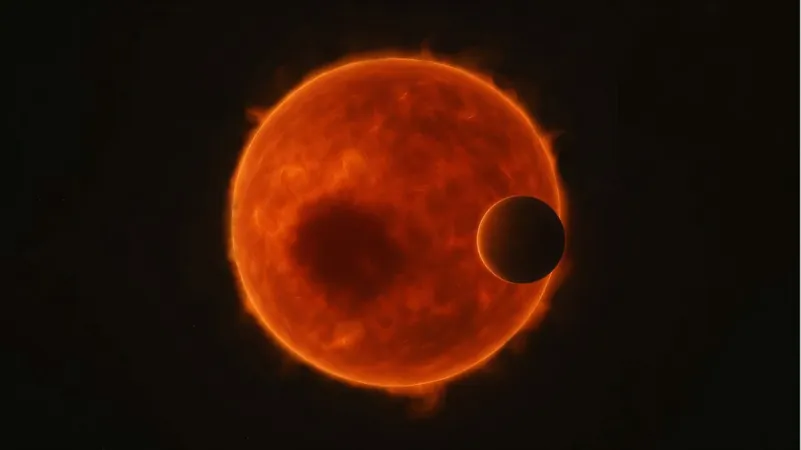
Unlocking the Secrets of TOI-3884: A Breakthrough in Exoplanet Study!
2025-09-11
Author: Sarah
Spot-Crossing Transits: A Game Changer in Exoplanet Research
As scientists refine their studies of exoplanet atmospheres, understanding the impact of starspots has never been more crucial. One exciting way to investigate this is through spot-crossing transits, where a planet crosses directly over starspots, providing unique insights into both the star and the planet.
Revolutionary Insights from TOI-3884 System
A groundbreaking study led by an international team from the Astrobiology Center in Tokyo has shed light on the TOI-3884 system, utilizing advanced ground-based observations to detail starspot characteristics and the intricate geometry of its planetary system. Published in The Astronomical Journal, this research offers revealing insights that could reshape our understanding of how starspots influence planetary atmospheres.
NASA's JWST: A Catalyst for Discovery
NASA's James Webb Space Telescope (JWST) has transformed the landscape of exoplanet studies. By detecting much smaller variations in transit depth—down to a remarkable 0.01%—JWST has amplified the need to understand starspots, which can obscure or mimic signals from planetary atmospheres. This makes the findings regarding TOI-3884 all the more significant!
TOI-3884: A Distant Red Dwarf Star with a Super-Neptune
Located about 140 light-years away, TOI-3884 is a red dwarf star housing a fascinating planet, TOI-3884b, a "super-Neptune" that boasts a radius six times that of Earth. The planet exhibits a consistent spot-crossing signal—an occurrence that is both rare and invaluable for researchers aiming to dissect properties of starspots while simultaneously studying orbital dynamics.
Resolving Discrepancies in Key Orbital Parameters
Previous studies had led to conflicting ideas about the parameters of the TOI-3884 system, especially in terms of stellar inclination and rotation speed. The recent study leveraged enhanced ground-based observations to resolve these uncertainties.
Capturing Spot-Crossing Signals with Advanced Technology
Using the state-of-the-art MuSCAT3 and MuSCAT4 instruments mounted on Las Cumbres Observatory's 2-meter telescopes, researchers observed three transits between February and March 2024, successfully identifying clear signals from starspots. This data is pivotal as it reveals temperature differences in starspots, which were found to be approximately 200 K cooler than the star's surface.
Revealing the Stellar Rotation Period
In an exciting twist, a photometric monitoring campaign from December 2024 to March 2025 indicated that TOI-3884's rotation period is a striking 11.05 days. This crucial finding corroborates the shifts in starspot positions during transits, leading to an unparalleled understanding of the system's geometry.
A Tilted Planetary System: Intriguing Implications
Diving deeper into the dynamics, the researchers discovered that the spin axis of TOI-3884 is misaligned by about 62° with the planet's orbital axis—a significant tilt suggesting past gravitational interactions with other massive planets or stellar companions, which are notably absent in this case. This peculiar arrangement makes the TOI-3884 system a captivating subject for future studies.
The Future of Atmospheric Studies on TOI-3884b
With TOI-3884b emerging as a prime target for atmospheric research using JWST and other observatories, this newly acquired knowledge about stellar and orbital characteristics is set to enhance the interpretation of its atmospheric observations. The potential discoveries await!





 Brasil (PT)
Brasil (PT)
 Canada (EN)
Canada (EN)
 Chile (ES)
Chile (ES)
 Česko (CS)
Česko (CS)
 대한민국 (KO)
대한민국 (KO)
 España (ES)
España (ES)
 France (FR)
France (FR)
 Hong Kong (EN)
Hong Kong (EN)
 Italia (IT)
Italia (IT)
 日本 (JA)
日本 (JA)
 Magyarország (HU)
Magyarország (HU)
 Norge (NO)
Norge (NO)
 Polska (PL)
Polska (PL)
 Schweiz (DE)
Schweiz (DE)
 Singapore (EN)
Singapore (EN)
 Sverige (SV)
Sverige (SV)
 Suomi (FI)
Suomi (FI)
 Türkiye (TR)
Türkiye (TR)
 الإمارات العربية المتحدة (AR)
الإمارات العربية المتحدة (AR)